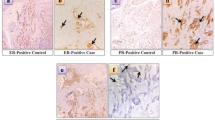Abstract
Objective
The aim of the present study is to explore the expression of a specific marker of breast cancer, small breast epithelial mucin (SBEM) mRNA, in peripheral blood and to investigate its significance.
Methods
The expressions of SBEM-mRNA in peripheral blood of 67 patients with breast cancer, 16 patients with benign breast disease, and 20 normal healthy volunteers were detected with nested reverse transcription-polymerase chain reaction (Nested-RT-PCR).
Results
SBEM-mRNA was negative in healthy individuals and patients with benign breast tumor, but 50.7%(34/67) of breast cancer patients showed positive expression of SBEM-mRNA in peripheral blood, of whom 25%(2/8) were in stage I, 45.8%(11/24) in stage II, 43.75%(11/24) in stage III and 73.7(14/19) in stage IV. The positive rate in stage IV was higher than that in stage I, II, III (P<0.05). Expressions of SBEM-mRNA had no correlation with age, carcinoma size, pathological type, ER and PR state (P<0.05).
Conclusion
SEBM-mRNA is specifically expressed in breast cancer and it may act as a marker for the detection of micrometastasis of breast cancer.
Similar content being viewed by others
References
Bundred NJ. Prognostic and predictive factors in breast cancer[J]. Cancer Treat Rev 2001; 27:137–142.
Ghossein RA, Rosai J. Polymerase chain reaction in the detection of micrometastases and circulating tumor cells[J]. Cancer 1996; 78: 10–16.
Fabisiewicz A, Kulik J, Kober P, et al. Detection of circulating breast cancer cells in peripheral blood by a two-marker reverse transcriptase-polymerase chain reaction assay[J]. Acta Biochim Pol. 2004; 51:747–755.
Kawakita M, Hiramatsu K, Sugimoto M, et al. Clinical usefulness of urinary diacetylpolyamines as novel tumor markers[J]. Rinsho Byori 2004; 52:321–327.
Schuler GD. Pieces of the puzzle: expressed sequence tags and the catalog of human genes[J]. J Mol Med 1997; 75: 694–698.
Hatey F. Expressed sequence tags for genes: a review [J]. Genet Sel Evol 1998; 30: 512–541 and Serial Analysis of Gene expression—SAGE [Velculescu VE, Zhang L, Vogelstein B, et al. Serial analysis of gene expression[J]. Science 1995; 270: 484–7.
Miksicek RJ, Myal Y, Watson PH, et al. Identification of a novel breast-and salivary gland-specific, mucin-like gene strongly expressed in normal and tumor human mammary epithelium[J]. Cancer Res 2002; 62: 2736–2740.
YE Jing; SHAN Bao-en. Research on Breast Cancer Susceptibility Genes [J]. Chin J Cancer 2002; 21:1035–1039.
Berois N, Varangot M, Aizen B, et al. Molecular detection of cancer cells in bone marrow and peripheral blood of patients with operable breast cancer. Comparison of CK19, MUC1 and CEA using RT-PCR[J]. Eur J Cancer 2000; 36: 717–723.
Stathopoulou A, Mavroudis D, Perraki M, et al. Molecular detection of cancer cells in the peripheral blood of patients with breast cancer: comparison of CK-19, CEA and maspin as detection markers[J]. Anticancer Res 2003; 23: 1883–1890.
Roncella S, Ferro P, Bacigalupo B, et al. Human mammaglobin mRNA is a reliable molecular marker for detecting occult breast cancer cells in peripheral blood[J]. J Exp Clin Cancer Res 2005; 24: 265–271.
Mori M, Mimori K, Ueo H, et al. Molecular detection of circulating solid carcinoma cells in the peripheral blood: the concept of early systemic disease[J]. Int J Cancer 1996; 68: 739–743.
Liotta LA, Stetler-Stevenson WG. Tumor invasion and metastasis: an imbalance of positive and negative regulation[J]. Cancer Res. 1991; 51(18 Suppl): 5054–5059.
Meric-Bernstam F. Breast conservation in breast cancer: surgical and adjuvant considerations[J]. Curr Opin Obstet Gynecol 2004; 16:31–36.
Gerber B, Scholz C, Reimer T, Briese V. et al. Complementary and alternative therapeutic approaches in patients with early breast cancer: a systematic review[J]. Breast Cancer Res Treat 2005; 28:1–11.
Paik S, Shak S, Tang G, et al. Expression of the 21 genes in the Recurrence Score assay and tamoxifen clinical benefit in the NSABP study B-14 of node negative, estrogen receptor positive breast cancer[J]. ASCO Annual Meeting, 2005.
Author information
Authors and Affiliations
Corresponding author
Additional information
Foundation item: This work was supported by the Natural Science Foundation of Guanxi Province (No. 0640161).
Biography: YANG Hua-wei (1973–), male, master of medicine, Guangxi Medical University, majors in surgical oncology.
Rights and permissions
About this article
Cite this article
Yang, HW., Yang, NW., Cao, J. et al. Detection of SBEM-mRNA in peripheral blood of patients with breast cancer and its clinical significance. Chin. J. Cancer Res. 18, 294–298 (2006). https://doi.org/10.1007/s11670-006-0294-4
Received:
Accepted:
Issue Date:
DOI: https://doi.org/10.1007/s11670-006-0294-4




